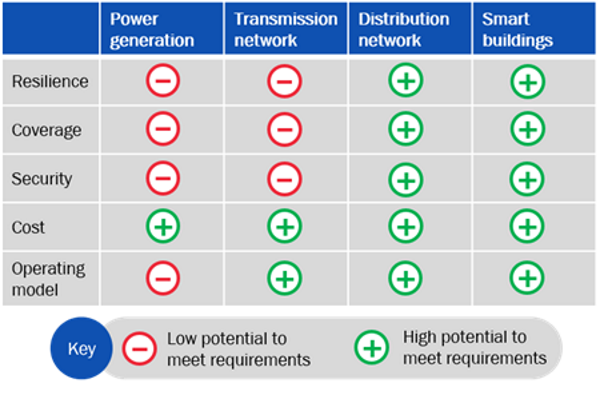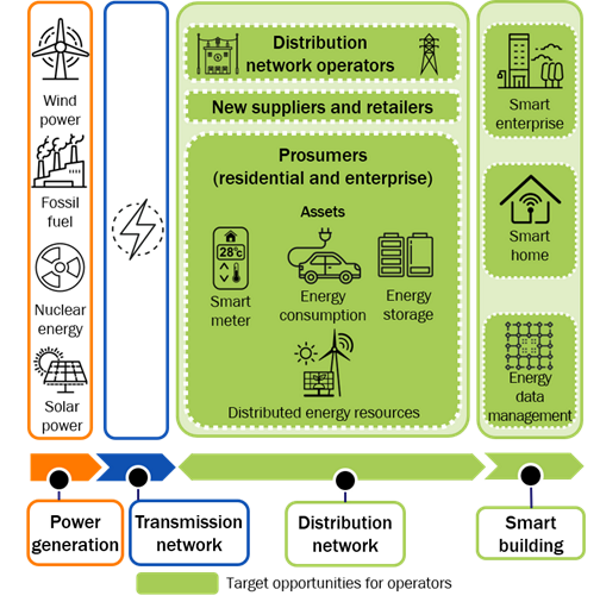Smart-grid opportunities for operators are emerging, but challenges remain

Operators that offer cellular technology to electricity companies have an immediate opportunity to generate revenue by working with distribution network operators (DNOs) in the smart meter sector. Some operators have already had success in this market, such as Proximus, Telefónica UK and Vodafone. However, operators have had limited success further up the electricity supply chain in the high- and medium-voltage transmission and power generation domains. Operators may be better placed to provide services ‘behind the meter’ than in the higher-voltage parts of the electricity network.
This article summarises some of the findings from our recent reports on smart-grid opportunities for operators, IoT in the smart grid: opportunities for operators and Smart grid: case studies and analysis.
There are a number of challenges for operators that wish to address the requirements of the electricity sector
Operators that are addressing the electricity sector face multiple challenges due to their demanding and stringent nature of the sector’s the requirements. Electricity companies are undergoing their own transformations as a result of the move to a smarter grid. They are in the process of deploying active network management solutions to monitor, control and automate many of their assets and processes. Cellular networks may be sufficient for low-voltage ‘consumer’ assets at the edge of the network such as smart meters, but they are often deemed to be insufficient for critical assets further up the supply chain in transmission and generation. Hence, cellular connectivity has not been widely adopted in these domains. Our research on smart-grid opportunities (see links above), which included interviews with operators and electricity companies, highlighted a mismatch between the electricity companies’ requirements and operators’ connectivity offerings in some domains.
Figure 1: The potential of public cellular networks to meet the requirements of the electricity supply chain
Source: Analysys Mason, 2019
Figure 1 illustrates some of the criteria that utilities consider when selecting which network technologies to use to connect their assets. Coverage and resilience were the key concerns that were expressed by electricity companies during the course of the research.
- Coverage. Public networks were developed to prioritise population coverage rather than geographic coverage and hence do not meet the requirements of assets that are often situated in rural locations.
- Resilience. Utilities are subject to strict regulation with regard to resilience; networks have to be resilient to enable the quick recovery of the power system.
These issues cannot be easily addressed by operators; their business models and network deployment techniques are predicated on meeting the requirements of their traditional smartphone customers.
However, some electricity companies do believe that the private network model may be able to support some assets, although question marks still remain regarding coverage and resilience. Similarly, these companies also expressed some scepticism over the potential for 5G to address the issues of coverage and resilience, although there was interest in network slicing.
The electricity sector is typically risk-averse and slow to adopt new technologies. Players in the sector are unlikely be early adopters of 5G. For these reasons perhaps, operator 5G trials have tended to focus on the nearer-term opportunities in the automotive market and industrial IoT. None of the operators that were interviewed for this research (all of which have built sizeable teams to target the utilities opportunity) had undertaken 5G trials that were focused on the electricity sector.
Operators’ connectivity solutions are potentially a better fit for new opportunities ‘behind the meter’1
Operators continue to explore new business with traditional electricity companies, primarily in the distribution network, but also further up the supply chain. For example, activity that is driven by the growing deployment of NB-IoT and LTE-M to connect substation infrastructure (such as pumps and valves) and low-voltage link boxes. However, as the smart grid develops, operators have a growing opportunity to provide connectivity services to new players. This is illustrated in Figure 2.
Figure 2: Smart-grid opportunities for operators
Source: Analysys Mason, 2019
There is a proliferation of new companies that generate, supply and consume energy, and require connectivity to manage communications at the point of integration with the grid as well as across their microgrid. These are potential new customers for operators, and they include, but are not limited to:
- prosumers (large commercial and residential users or communities that generate energy from renewables to consume, store and supply to others)
- electric vehicle charging (EVC) network suppliers
- facilities management companies or social housing organisations.
The last group of companies represents the adjacent smart building market opportunity; operators and other players can provide energy data management solutions to manage the energy supply and demand for large commercial and residential buildings. Connectivity to the grid is not required, but operators could use the skills and assets acquired for the energy sector to better address the requirements of the smart buildings sector.
Competition in the emerging smart-grid market is likely to intensify
The emerging ‘behind the meter’ opportunity could be significant, and is subject to less-stringent regulatory requirements than the traditional utilities sector. Cellular networks will probably be well-suited to meet the requirements of these emerging applications in terms of coverage and resilience, and there is no entrenched market competition However, as a result, the barriers to market entry will be lower and other types of connectivity provider than just operators will want to get involved. Operators will need to act quickly to demonstrate their commitment to the opportunity, win customers and counter the competition.
1 ‘Behind the meter’ is used to refer to the generation of renewable energy by commercial and residential customers.
